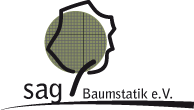“Electrical Resistiance Tomography.”
Electric current is passed through the tree trunk as a conductive medium. This is achieved with direct current or low frequency alternating current. The current is passed through the wood body via the apoplast (cell walls and intercellular space). The electrical resistance is influenced by the wood moisture content and by the ion content (Weihs et al. 2007).
In the presence of disease, injury, or the activity of wood-decomposing fungi, wood moisture content and ion concentration in the apoplast can be increased, resulting in improved conductivity in the affected areas (Rinn 2003, Weihs et al. 2007). The visualisation of the properties in the electrical resistance tomograph does not, on its own, allow any conclusions to be drawn about the load-bearing capacity of the tree stem. However, it can provide complementary information to help improve the interpretation of the sonic tomograph.
Since the electrical resistance tomograph is more sensitive to changes in properties of wood, its use can contribute to the early detection of rot (Duhme et al. 2007). In addition, the electrical resistance tomograph can be used to detect decay in wet cores or cracks; the sonic tomograph has limitations in this case (Clasmeier & Rust 2012). Altered biochemical properties of intact wood, which can occur with coring or reaction wood formation, can also be detected in many cases using electrical resistance tomograph.
The water content and ion concentration of different tree species varies greatly. For this reason, an ERT must always be viewed in comparison with tomograms of healthy cross-sections of the same tree species.
Sources
Clasmeier, O. & Rust, S. 2012: Möglichkeiten der kombinierten Anwendung von elektrischer Widerstandstomographie und Schalltomographie am Beispiel von Rosskastanien, Jahrbuch der Baumpflege, Hrsg.: Dujesiefken, D., Thalacker Medien. Braunschweig, S. 251-258
Duhme, M., Bieker, D., Gustke, B., Weihs, U., Rust, S. 2007: Kombinierte Anwendung von elektrischer Widerstandstomographie und Schalltomographie an Rosskastanie, Jahrbuch der Baumpflege, Hrsg.: Dujesiefken, D., Thalacker Medien. Braunschweig, S. 311-314
Rinn, F. 2003: Technische Grundlagen der Impuls-Tomographie, Baumzeitung 8, S. 29-31
Rinn, F. 2004: Holzanatomische Grundlagen der Schalltomographie an Bäumen, Neue Landschaft 7, S. 44–47
Rust 2017: Accuracy and Reproducibility of Acoustic Tomography Significantly Increase with Precision of Senosr Position. Journal of Forest and Landscape Research 1 (2017): 1–6, DOI: 10.13141/jflr.v2i1.449
Rust S., Franz S., Minke M., Schumann I., Roloff A. 2002: Schalltomographie zur Erkennung von Fäulen und Höhlungen an stehenden Bäumen. Stadt Grün 6, S.50–52
Rust, S & Weihs, U. 2007: Geräte und Verfahren zur eingehenden Baumuntersuchung, In: Jahrbuch der Baumpflege, Hrsg.: Dujesiefken, D., Thalacker Medien. Braunschweig, S. 215-229
Weihs, U., Bieker, D., Rust, S. 2007: Zerstörungsfreie Baumdiagnose mittels „elektrischer Widerstandstomographie“, In: Jahrbuch der Baumpflege, Hrsg.: Dujesiefken, D., Thalacker Medien, Braunschweig, S. 230-241


